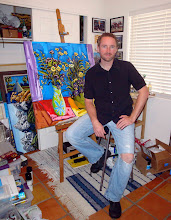
This week I must admit that I am still working on the new Acoma Pueblo painting that I talked about last week. The maze of ladders, shadows, and the long range of delicate pink and ochre colours are all keeping me plenty busy. But this one is 87% done, and will likely see the end of the road in the next few days. New works have also been posted on the "New Paintings" page of my official website at http://www.neilmyers.homestead.com/ , including my first painting of the Sierras called "Yosemite Valley." This work is part of an extended group of themed paintings that I will be doing that is inspired by our amazing national parks.
One thought that has been buzzing around my head came up after a talk with a gallery director this past week. He was mentioning that some collectors did not look favorably on a painting of mine that depicted a dead Saguaro. It got me to thinking about the kind of works that people buy - and those subjects which have sold the best for me, and it does seem to me that there is a low level, perhaps unspoken, preference for seeing any plant or landscape in full bloom - or in the prime of its life. If this is true, as it seems it is in many instances, I have to admit that I don't understand where it comes from.
I think it was Camille Pissaro who complained in a letter that all the Paris collectors wanted at that particular time was "Haystacks, Summer Sunshine" by Claude Monet. So is there now, as there seemed to be then, a preference for just certain seasons of natural life?
I believe that if you fancy yourself as an appreciator of natural beauty, then you are obliged to appreciate it in all its forms and stages of life - including that of death. All around the Sonoran desert we have these grand old skeletons of Saguaros that continue to stand, poking their wooden, spindly forms into the air often long after they die. They form a stark contrast to the olive-greens of the living Saguaros - as the dead ones and their wooden skeletons add yet another color and feature to our desert. Some collapse and you come across them decaying on the ground. They are interesting artistically, for the main reason that the Saguaro has such a long lifespan. It is not uncommon for them to live for up to 200 years or more. And they are often around 50 years old before they are even large enough to sprout a single arm.
I've heard some people say that there is a cultish obsession in America with youth - and that we don't value the wisdom of age and the stages of life the way we really should. And perhaps this was emerging in the comment about my Saguaro painting. Of course, a collector is obliged to buy or enjoy whatever images they like - and I for one am simply grateful that wonderful collectors continue to purchase my works and give me great motivation to keep going. However I can only encourage everyone to broaden their vision, and learn to see the beauty in all living things - and appreciate them at every point of their existence, including the end.
The autumn and the winter are just as beautiful as the spring and summer.
*All Images are Copyright Neil Myers 2007

